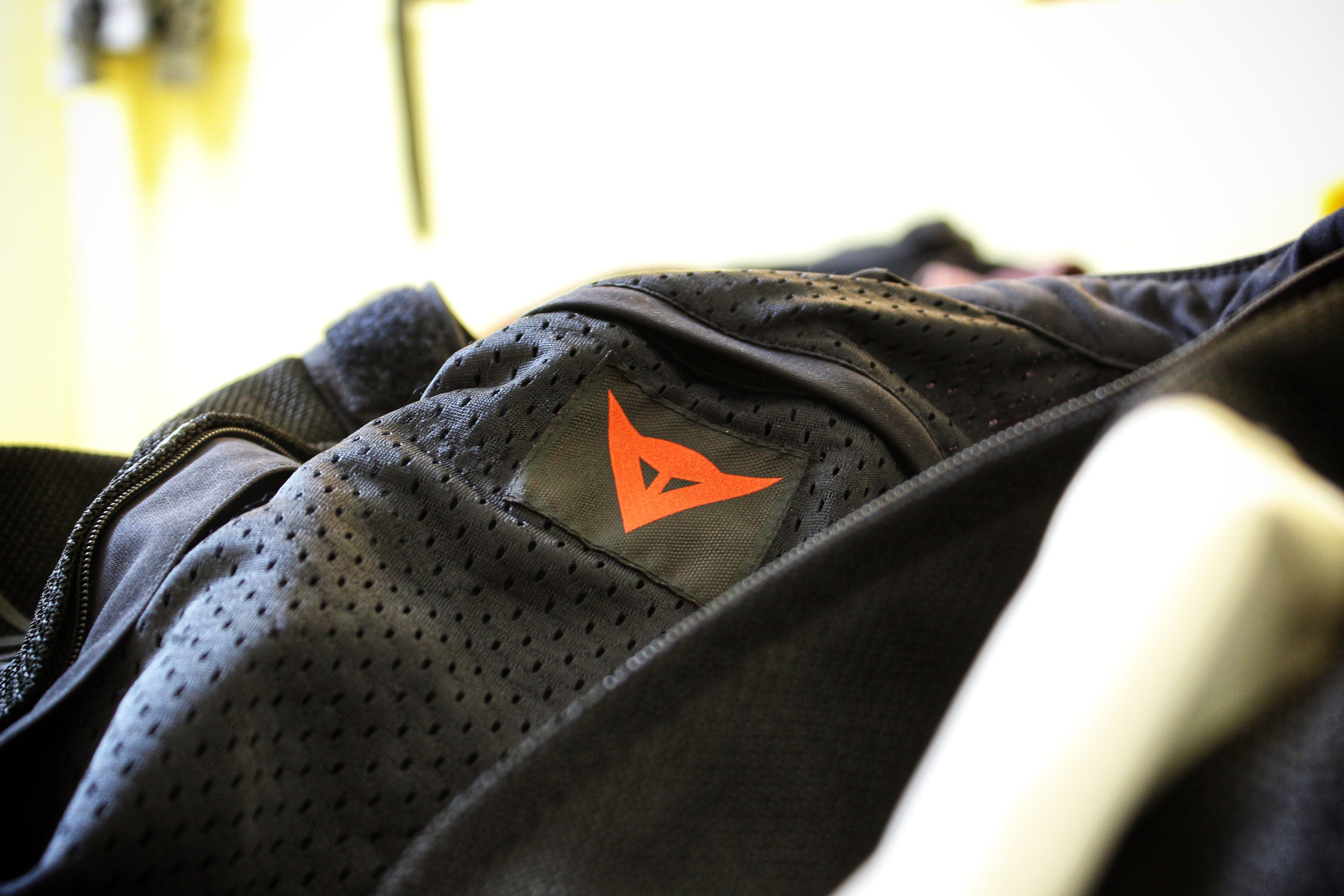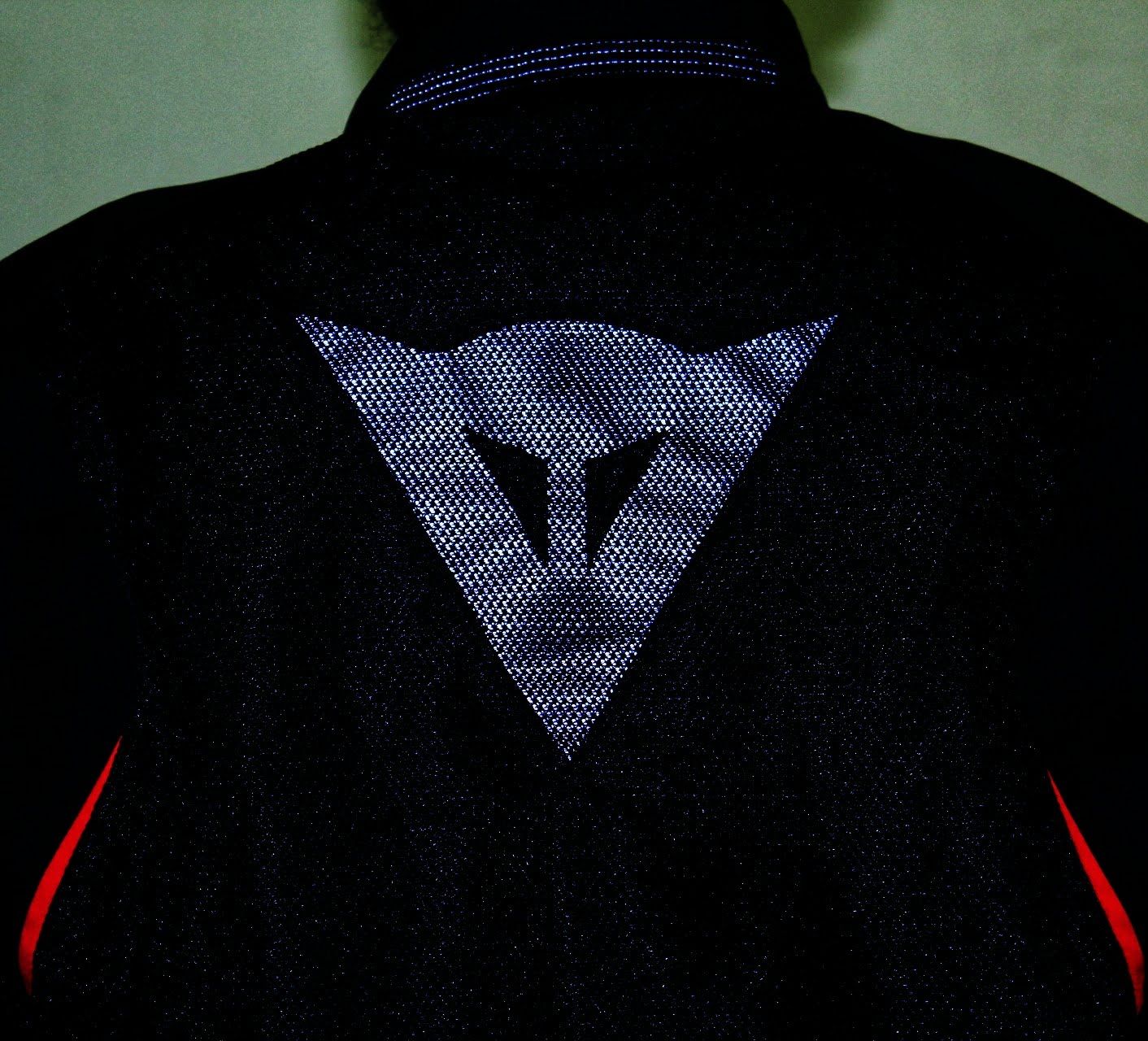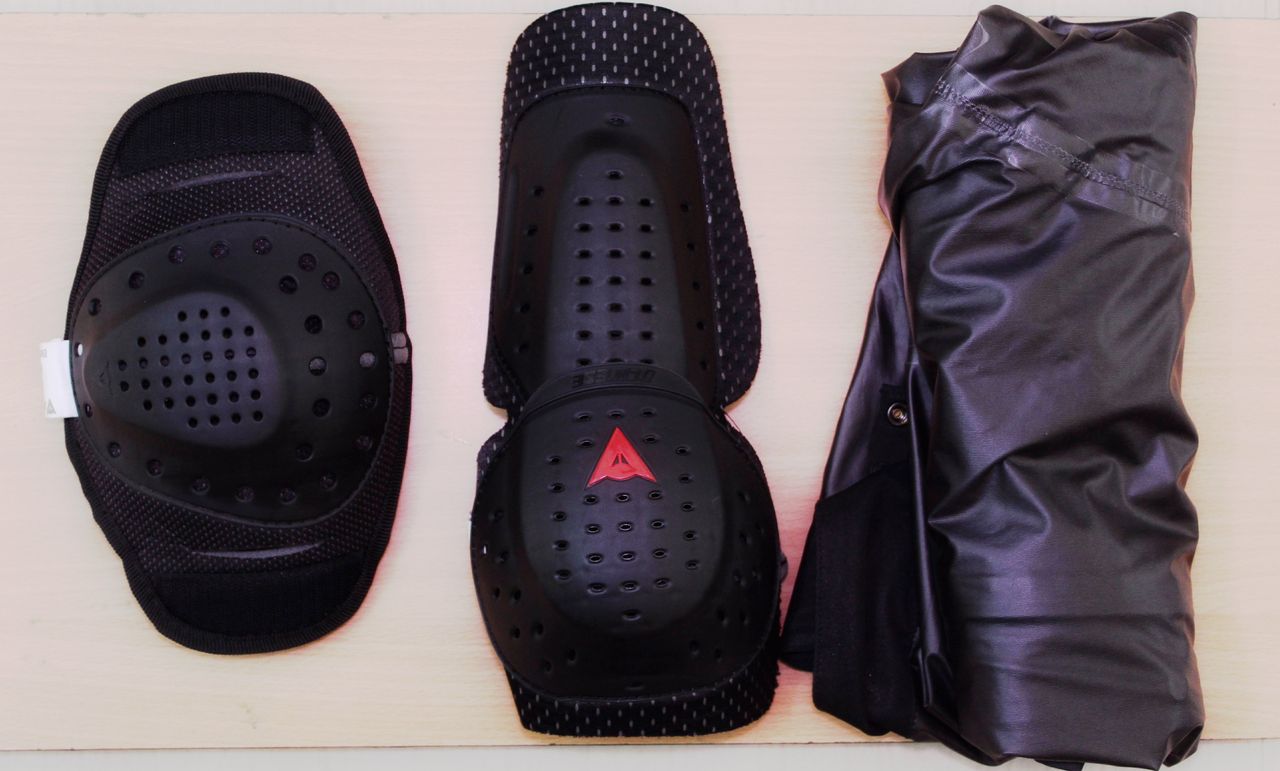Dainese Hydra Flux D-Dry Jacket
Bengaluru, Karnataka, India

Top notch quality is guaranteed with that logo.
It was time to let go of my riding jacket and get a new one. Just like everything else, I had my specific set of requirements. To meet them I had to consider what I can afford to compromise on.
I found the Dainese Hydra Flux D-Dry to be ideal for my usage:
- Super lightweight and comfortable, almost a second skin.
- Basic but adequate protection, except for the lack of back protection.
- Incredibly good air flow.
- Extremely utilitarian D-Dry membrane that can fit in a pocket when not in use.
While it is by no means perfect, and almost too flawed for many motorcycling markets, it hits the right marks. Here are my thoughts on how it makes an almost perfect everyday riding jacket with a few specific goodies that bring a lot of practicality to my life.
If riding conditions permit, most of us could make do with just one jacket
Safety is not the only job a jacket serves, we put so much demand on our gear without realizing it. It has to protect us from the elements, which means keeping us warm in the cold, but also not cook us in the heat. It has to look good, cause let's face it, no one among us wants to look bad while riding. Our demands vary significantly based on the type of riding we do and where we do it. So, it is safe to assume that, just like purchasing a motorcycle, riding gear too is quite a personal affair.
With my expectations set clear, I went looking for my “perfect” jacket
I knew I had quite a bit of research to do if I didn't want to regret my purchase. What I was looking for was an all-rounder jacket that I can use on a 1,000 KM ride out to some beautiful twisties and still not be out of place when I go to the movies at a mall 20 KM from home. I ride every day of the week, throughout the year, but owing to a fairly warm climate, I knew I had to get a mesh jacket.
Textile jackets might be suitable for most of the time, though, in the really hot days, even that can be uncomfortable. I do ride in some cool weather conditions from time to time, but that can be taken care of by some layers.
It’s monsoon that I really need to consider as an exception to the heat. Some form of water resistance would be appreciated, enough to let me reach a place where I can stop and put the raincoat on if the heavens open. I am introvert by nature and do not wish to attract too much attention, so something that isn’t too flashy would be ideal as well. But I also don’t want something that takes form over function.
It was clear from the start that I did not need/want to invest on top of the line touring/adventure specific jackets as they cost a bomb and I’ll stick out like a sore thumb in a place where a helmet is only worn to avoid fines and spending more than $20 on one is considered a waste of money.
My options were quite diverse though, as we have many indigenous brands that cater to our riding conditions and also don’t cost too much. For example, the TBG Knight mesh jacket offers SAS-TEC CE level 2 armour and a host of features while costing as little as $156. The thing with these local products is that they are great value for money and offer better protection than similarly priced options from more premium brands. At the same time, their fit has been an issue for me, and after trying out many from different manufacturers, I gave up on them. Don’t get me wrong though, they are brilliant products and the fact that they don't fit me is because I am a little person.
Finally, as many friends suggested, I decided to go a bit upmarket and look into the European brands. The options I had easy access to were Alpinestars, Dainese, and Furygan. My primary option from the Alpinestars camp was the Alpinestars T-jaws V2 Air and Alpinestars Viper Air. I am aware that there are other options from them, but these were the only ones I could easily source from trusted suppliers. The later was available at a good price, but also lacked some of the things I was looking for. The fact that it came with a vest type liner want very reassuring either. The Alpinestars T-jaws V2 Air, on the other hand, was my top pick because I have worn it before and liked the fit and ventilation provided.
From Furygan, I had Discovery Mesh Jacket which was better than the Alpinestars T-Jaws V2 Air in terms of ventilation and also came with D3O shoulder and elbow armour. I also liked the way it looked, and it was available at a significantly cheaper price than the competition.
I never gave much thought to Dainese because of the high premium
Dainese was my last choice and the only thing they had going for them is that we had an exclusive store quite close by. One fine day I decided to visit the local D-Store with a friend: the Dainese exclusive dealer. I visited the store the previous night and one jacket caught my attention more than any other, the Dainese Hydra Flux D-Dry. It is a derivative of their Air Flux jacket, a mostly mesh jacket at the bottom of their range. It had the basic protection that I was aiming for: some degree of wind/rain proofing to allow me the time to put on proper rainwear and looked discreet enough to wear to public places.
I was surprised to find that not only did they have stock of the size that I needed, but that it fit me perfectly. It just felt like a second skin, with a better fit only possible by custom-fit leathers. It is also so light that it basically felt like a normal hoodie. But an MSRP of roughly US$270 meant that it was grossly overpriced for what was essentially a basic jacket that looked good, fit well and flowed a lot of air.
Then I came to know that they were having a sale and I ended up making the purchase at $200. It was still quite expensive for the protection it offered, but being as light as it is meant that I’d wear it more often and there is no better protection than what you have on. The D-Dry in the name also meant that it came with an internal liner which has quite a bit of utility, but I’ll get to that later.
It might seem that I jumped the gun with this purchase, but I had done my research on the available option from Alpinestars, the T-jaws V2 Air. But that one didn’t fit me as well as the Dainese, has less mesh and hence will get hot during peak traffic hours during my commute. The $200 cost also meant that the difference the Dainese and Furygan was too negligible, especially considering that the Furygan had no waterproofing that I could find when I saw it in the stores.
A mostly mesh jacket, with Quick Dry fabric doing duty elsewhere
Enough of context, moving on to the actual jacket. The Dainese Hydra Flux D-Dry is one of Dainese’s entry-level jacket and hence is the least technical from the entire range. Primary construction materials are Boomerang Mesh and Quick Dry fabric. The former is a high tensile mesh fabric and there is plenty of that on this jacket. The front and most of the back are made of this cool material that is lightweight and aids air flow. I do have my doubts about the abrasion resistance of this material, but if I wanted ultimate protection, I should be looking at leather anyways and that isn’t an options when you are mostly riding at 30° C.
The remainder of the jacket is made out of the aforementioned Quick Dry fabric, which is placed at the more impact prone areas of the body. This adds to the abrasion resistance of those areas and is said to dry very quickly. Truth be told, I am unable to find more details about what makes these fabrics different from the stuff used to make other jackets. Even if there were differences, I’d bet that they are minor at best. But what all this results in is a jacket that is super light and flows air extremely well. I have worn it in middle of the day at 30° C, barely moving in the choked traffic and was surprised to see that I didn’t sweat at all. As I mentioned earlier, the jacket is very light, feeling barely heavier than regular clothing. So overall, I’d say that my airflow requirements have been met.
Visibility wise, the jacket is a little underwhelming though, as there are only a few reflective areas. The most prominent ones being the Dainese logos on the shoulder and the almost hidden logo in the back. There is a bit on the sleeves and the back of the neck as well. While I’d have preferred a bit more reflectivity, especially on the front, what is available functions as expected.

Most of the visbility is dependent on this logo, which looks quite good at night.
Fit wise, this a slim cut jacket with a strict European fit. So it fits snug and follows the contours of the body quite well. Which is great considering that was what I wanted to begin with. Though this may mean that it won’t be a good match for other body types.

The best fit I have come across for myself so far.
Protection is basic but comfortable and unrestrictive
The protection provided by this jacket is basic by any standards, but remains comfortable and doesn’t restrict movement. We have CE rated (EN 1621.1) armor on the shoulders and elbows, and I am extremely happy to note that the elbow armor extends down to most of my lower arm. The protection seems to be good enough for city riding and slower sport touring. I do feel that the shoulder armor puts some pressure on the shoulders when wearing a backpack, but that could be because of how skinny I am.
We also have a pocket for a back protector which advertises support for Dainese’s own G1 And G2 back protector. That also means that this jacket doesn’t come with any kind of back protection out of the box. But that was expected considering this is an entry level jacket in the range. I’d have liked to see at least a foam protector at the back and even with that, this is strictly adequate and nothing special about this jacket in terms of protection.
As mentioned above, it comes with support for G1 and G2 back protectors, but I will be seeing if a D3O Viper Pro Spine/Back Armor fits. Adjustments are available at the neck, cuffs and the waste, all of which are of the velcro variety. I’d have preferred a snap-on button type adjuster for the neck as the velcro stick to the inner mesh fabric and pulls on the strings, causing visible damage to the fabric.
You might have noticed that I did not mention any adjustments for the biceps of the elbows and that is because they aren’t available. Which is a shame cause I’d have preferred that the biceps be a little bit tighter, though these are problems only a skinny guy would understand.

The shoulder armor, elbow armor and the D-Dry liner, notice how small the liner is.
The waterproofing is only basic but improves the utility of this jacket quite a bit
The real reason I chose this jacket over the others is the D-Dry liner that comes with it. To begin with, many other jackets come with rain and windproof liners, but this one has a few practical advantages that I am impressed with. Dainese’s website describes it as a breathable, rain and windproof liner and I have to agree that the breathable part is true.
I have worn the jacket every day of the week for the past 3 months and most of it is with the liner on. It has helped me cope with the chilly winter mornings of Bangalore (chilly for an Indian), but at the same time, I can ride on in the middle of the day at 25-30 °C, without any issue if I forget to remove it. Without the liner, the jacket is super cool and with it, more than manageable in regular heat. That is a practical advantage for anyone who rides in humid regions and I am very appreciative of this feature. But it is not perfect by any means, especially with the 2 external pockets being above the waterproof liner and hence useless if it starts raining. So I make it a point to not leave stuff like wallets and phones in there; as a matter of fact, I only use it to keep my earplug case. Another thing is that the liner itself is not as long as the jacket and even with a waterproof D-Dry pants, you’d still get wet around the region where the pant meets the jacket. On the positive side, the liner itself can be rolled up and kept in a pant pocket or something, i.e it takes very little space when not in use.
Speaking of pants, I was very disappointed at the fact that this jacket doesn’t come with a zipper to attach Dainese riding pants to it. While this is the entry level jacket in the lineup, how much more expensive was it going to be for them to put that zipper on? Come on Dainese, this is still a fairly expensive purchase considering how much cheaper similar products are from other brands. This bit of saving was a little too far in my opinion. The kind folks at the D-Store did say that they can add it on, but I think that may compromise the integrity of the jacket and I am not sure I’ll do that.
Expensive, but unique in its own way
Would I recommend you purchase this? It’s, unfortunately, a yes and a no. It is a no if you have to pay the $270 MSRP, especially if this is going to be your only jacket, or if you can make do with the lesser ventilation offered by other jackets from the competition that don’t feature as much mesh. If the waterproofing is of no practical significance to you, you can also consider the Furygan Discovery, though if you live in a more developed market there are even more options. If you are looking for proper waterproofing, look elsewhere, as this isn’t made for that purpose either. Although if you have other jackets in your collection to deal with the shortcomings of this jacket and just need something that flows a lot of air, for your daily commutes I’d say yes, consider this. But even then, unless you get a discount like I did, it isn’t value for money. But hey, it’s a Dainese and they are not known for being value for money anyways.
What this jacket does well is a casual riding gear that you won’t have an excuse not to wear the next time you ride in the heat or expect to hit a small shower, and that is important as the best protection is the one you have on. So, I will be getting one more jacket for more technical features and protection, but I do like this little piece of mesh and will keep using it for my daily commutes for the foreseeable future.
The Dainese Hydra Flux D_Dry is a unique mix of lightweight, incredible airflow and useful waterproofing, which makes it uniquely suited for what I need at the moment. Had I been in a colder region, or rode a faster bike; it would not have been ideal or even practical. But at the moment, it offers just the right amount of practicality and sacrifices for it to be worth my money and that is the thing about riding gear; our requirements depend on various variables. Fortunately, I found what suits me for now, so mission accomplished.
You must be logged in to comment
Login now